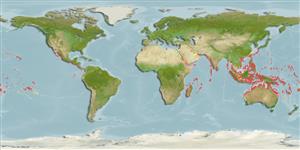分類 / Names
俗名 | 同種異名 | Catalog of Fishes(屬, 種) | ITIS | CoL | WoRMS | Cloffa
Teleostei >
Eupercaria/misc (Various families in series Eupercaria)
鱸形目 (Various families in series Eupercaria) >
Labridae (Wrasses)
隆頭魚科 (Wrasses) > Cheilininae
Etymology: Novaculichthys: Latin, novacula = razor + Greek, ichthys = fish (Ref. 45335).
More on author: Lacepède.
Environment: milieu / climate zone / depth range / distribution range
生態學
海洋 礁區魚類; 深度上下限 3 - 25 m (Ref. 30573), usually ? - 14 m (Ref. 27115). 熱帶; 24°C - 28°C (Ref. 27115); 30°N - 30°S, 32°E - 77°W
Indo-Pacific: Red Sea to South Africa (Ref. 35918) and the Tuamoto Islands, north to Ryukyu and Hawaiian islands, south to Lord Howe Island. Excluding Persian Gulf (Ref. 86689). Eastern Pacific: Gulf of California to Panama and the Galapagos Islands (Ref. 5227).
印度-太平洋: 紅海到南非 (參考文獻 35918) 與 Tuamoto 島, 北至琉球與夏威夷群島, 南至羅得豪島。 東太平洋: 加州灣到巴拿馬與加拉巴哥群島.(參考文獻 5227)
大小 / 重量 / 年齡
Maturity: Lm ? range ? - ? cm
Max length : 30.0 cm TL 雄魚/尚未辨別雌雄; (Ref. 2334)
背棘 (總數): 9; 背的軟條 (總數): 12-13; 臀棘 3; 臀鰭軟條: 12 - 13. Juveniles have long extended dorsal fin spines (Ref. 48636).
稚魚有長的擴大背鰭棘。 (參考文獻 48636)
Inhabit semi-exposed reef flats and lagoon and seaward reefs (Ref. 1602). Common in areas of mixed sand, and rubble that are subject to mild surge (Ref. 1602, 58466). Benthopelagic (Ref. 58302). Juveniles shallow on rubble amongst large bommies or protected open patches on reef crests and swim as if were a leaf floating along the bottom; large adults move along over large reef section, usually in pairs and typically turn or shift large pieces of rubble or debris that they grab and pull with their mouth or push over with their snout. Often, while one works the piece, the other grabs exposed prey. They are sometimes called rock-mover wrasse, but they don't move real rocks (Ref. 48636). Highly territorial (Ref. 9823). Feed on mollusks, sea urchins, brittle stars, polychaetes, and crabs (Ref. 5213); feeding is done by overturning large rocks to expose target preys. The young imitate drifting masses of algae (Ref. 2334). Marketed fresh (Ref. 9311). Minimum depth reported from Ref. 30874.
棲息於半裸露的礁石平臺與潟湖與臨海礁石。 (參考文獻 1602) 常見於混合沙子的區域,而且碎石那是受溫和的湧浪支配.(參考文獻 1602,58466) 在珊瑚礁冠與游泳上的大的 bommies 或遮蔽的開闊區塊中的碎石上的稚魚淺灘好像是沿著底部的一個葉漂浮; 大的成魚沿著大片礁石區上移動, 通常成對而且典型地轉動大片的碎石或者殘礫它們以他們的嘴抓拉或者以他們的吻推開。 時常,然而一操作塊,另一個抓握暴露出來獵物。 他們有時被稱為岩石-行動者的隆頭魚,但是它們不移動真正的岩石。 (參考文獻 48636) 高度具有領域性.(參考文獻 9823) 吃軟體動物,海膽,海星,多毛類動物與螃蟹;(參考文獻 5213) 進食被藉由推翻大的岩石暴露目標獵物做。 幼魚模仿漂流海藻叢。 (參考文獻 2334) 在市場上銷售生鮮地.。 (參考文獻 9311) 最小深度記錄自.參考文獻 30874.
Life cycle and mating behavior
成熟度 | 繁殖 | 產卵場 | 卵 | 孕卵數 | 仔魚
Oviparous, distinct pairing during breeding (Ref. 205).印度-太平洋: 紅海到南非 (參考文獻 35918) 與 Tuamoto 島, 北至琉球與夏威夷群島, 南至羅得豪島。 東太平洋: 加州灣到巴拿馬與加拉巴哥群島.(參考文獻 5227)
Randall, J.E., G.R. Allen and R.C. Steene, 1990. Fishes of the Great Barrier Reef and Coral Sea. University of Hawaii Press, Honolulu, Hawaii. 506 p. (Ref. 2334)
IUCN 瀕危狀態 (Ref. 130435)
無危 (LC) ; Date assessed: 16 February 2009
人類使用
漁業: 低經濟; 水族館: 商業性
更多資訊
參考文獻養殖養殖資訊品種遺傳學Electrophoreses遺傳率疾病加工NutrientsMass conversion
工具
特別的報告
下載 XML
網路資源
Estimates based on models
Preferred temperature (Ref.
123201): 24.9 - 29.3, mean 28.3 °C (based on 3357 cells).
Phylogenetic diversity index (Ref.
82804): PD
50 = 1.0000 [Uniqueness, from 0.5 = low to 2.0 = high].
Bayesian length-weight: a=0.01995 (0.01075 - 0.03703), b=2.96 (2.79 - 3.13), in cm total length, based on LWR estimates for this species & (Sub)family-body (Ref.
93245).
營養階層 (Ref.
69278): 3.3 ±0.40 se; based on food items.
回復力 (Ref.
120179): 中等的, 族群倍增時間最少 1.4 - 4.4年 (Preliminary K or Fecundity.).
Fishing Vulnerability (Ref.
59153): Low vulnerability (20 of 100).
Nutrients (Ref.
124155): Calcium = 55.7 [34.0, 89.0] mg/100g; Iron = 0.601 [0.357, 1.082] mg/100g; Protein = 18.5 [15.7, 20.7] %; Omega3 = 0.133 [0.089, 0.197] g/100g; Selenium = 25.8 [16.4, 44.3] μg/100g; VitaminA = 112 [36, 384] μg/100g; Zinc = 1.48 [1.07, 2.34] mg/100g (wet weight);
